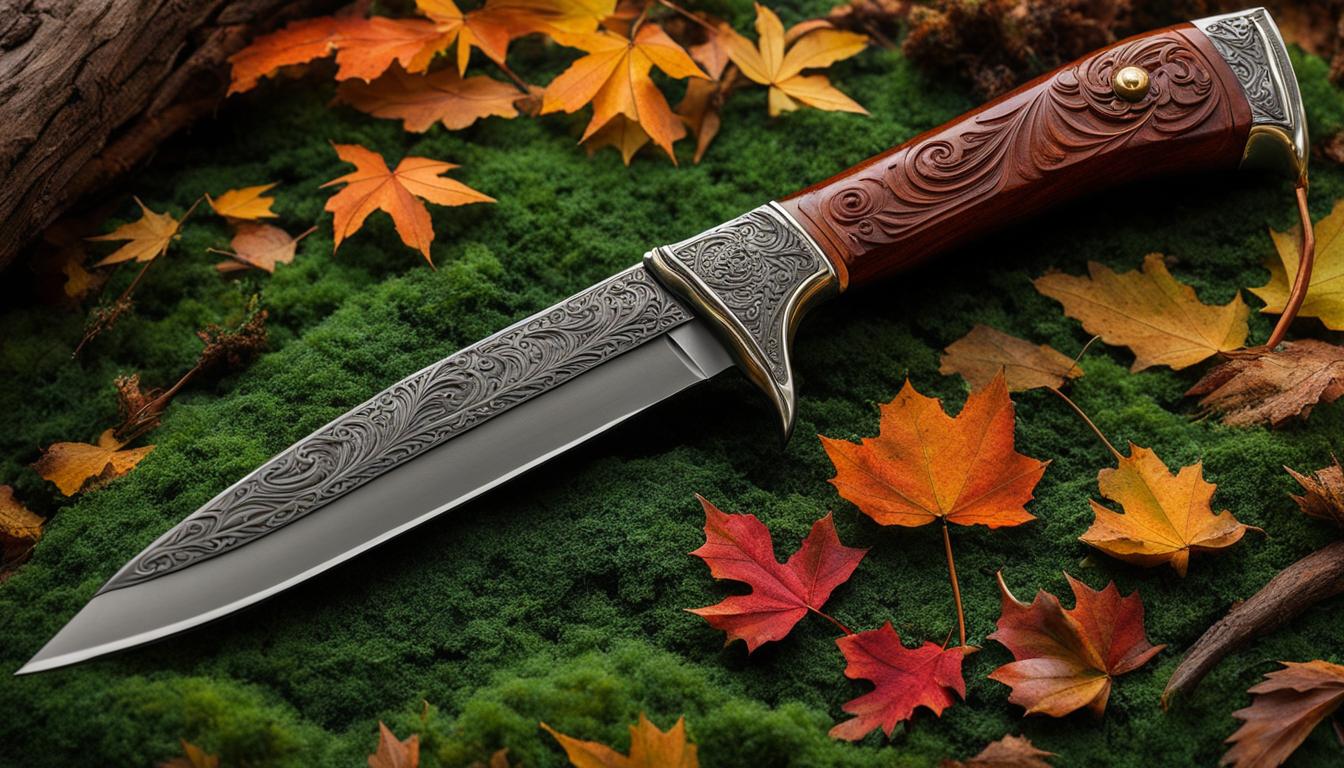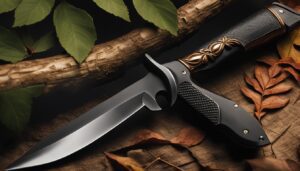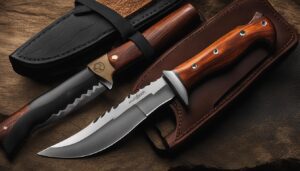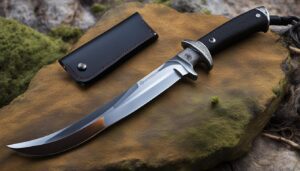When it comes to hunting, having the right equipment is crucial. One of the most essential tools for any hunting expedition is a custom hunting knife. In this comprehensive guide, we will explore the different aspects of finding the perfect custom hunting knife for your next adventure. We will delve into the anatomy of a hunting knife, the different types of blades, and the importance of quality and craftsmanship. By the end of this guide, you will be equipped with the knowledge to make an informed decision and find the ideal custom hunting knife for your specific needs and preferences.
Key Takeaways:
- Custom hunting knives are essential tools for hunting expeditions.
- Understanding the anatomy of a hunting knife helps in choosing the right one.
- There are different types of hunting knives, including fixed blade, folding, and pocket knives.
- Consider essential features such as blade material, handle design, and blade coating when choosing a hunting knife.
- Invest in a high-quality hunting knife for a reliable and enhanced hunting experience.
Understanding the Anatomy of a Hunting Knife
A hunting knife is a precision tool, and understanding its anatomy is essential for selecting the right one for your needs. Let’s delve into the different parts that make up a hunting knife and their functions:
Blade Point
The blade point is the tip of the knife and plays a crucial role in piercing, cutting, and slicing. Different blade points, such as drop point, clip point, or spear point, offer varying advantages depending on the intended use.
Blade Bevel
The blade bevel refers to the angle and shape of the cutting edge. It determines the sharpness and ease of sharpening the blade. A shallow bevel may provide better precision for skinning, while a wider bevel can enhance the overall strength of the blade.
Guard
The guard is a feature located between the blade and the handle. Its purpose is to prevent the user’s hand from slipping onto the blade during use, ensuring safety and stability.
Scales
Scales are the handle grips of a hunting knife. They are usually made of materials like wood, bone, or synthetic materials. Good-quality scales provide comfort and a secure grip, improving the user’s handling of the knife.
Tang
The tang is the portion of the blade that extends into the handle. It can be full or partial, with a full tang being more desirable for its strength and durability. A secure and solid tang ensures the knife can withstand heavy-duty tasks.
By understanding the anatomy of a hunting knife and the functions of each component, you can make an informed decision when choosing the perfect hunting knife for your next adventure.
| Blade Point | Blade Bevel | Guard | Scales | Tang |
|---|---|---|---|---|
| Piercing, cutting, and slicing | Determines sharpness and ease of sharpening | Prevents hand from slipping onto the blade | Provides comfort and grip | Extends into the handle, can be full or partial |
Exploring the Different Types of Hunting Knives
When it comes to choosing a hunting knife, there are several different types to consider, each with its own unique advantages and disadvantages. Understanding the differences between these types will help you determine which one is best suited for your specific needs and preferences.
Fixed Blade Hunting Knife:
One of the most common types of hunting knives is the fixed blade knife. As the name suggests, the blade on these knives is permanently fixed in place. Fixed blade knives are known for their durability and strength, making them ideal for heavy-duty tasks such as field dressing and skinning game. While they may be bulkier and less convenient to carry compared to other types, their solid construction and reliability make them a popular choice among serious hunters.
Folding Hunting Knife:
If portability and convenience are a top priority, a folding hunting knife may be the right choice for you. These knives feature a folding mechanism that allows the blade to be conveniently tucked away into the handle when not in use. Folding knives are compact, lightweight, and easy to carry, making them a great option for hunters who want a versatile tool that can be easily stored in a pocket or backpack. However, it’s important to note that folding knives may not be as durable as fixed blade knives and may have limitations when it comes to heavy-duty tasks.
Pocket Hunting Knife:
For hunters looking for the ultimate in compactness and portability, a pocket hunting knife is the way to go. These knives are designed to be small and lightweight, making them perfect for everyday carry. Pocket knives are often used for smaller game hunting or general utility tasks in the field. While they may not have the same level of strength and durability as fixed blade or folding knives, they offer unmatched convenience and versatility for those who prioritize mobility and ease of use.
When selecting a hunting knife, consider factors such as the intended use, your personal preferences, and the specific requirements of your hunting adventures. By understanding the differences between fixed blade, folding, and pocket hunting knives, you can make an informed decision and choose the type that best fits your needs.
Table: Comparison of Different Types of Hunting Knives
| Type of Hunting Knife | Advantages | Disadvantages |
|---|---|---|
| Fixed Blade | Durable and strong | Bulkier and less convenient to carry |
| Folding | Compact and easy to carry | May not be as durable for heavy-duty tasks |
| Extremely portable and versatile | May lack the same level of strength and durability |
Choosing the right hunting knife is a personal decision that ultimately depends on your specific needs and preferences. Whether you opt for a fixed blade, folding, or pocket hunting knife, each type offers its own set of advantages and disadvantages. Consider the intended use, portability, and durability when making your decision. Remember, a hunting knife is an essential tool that should provide reliability and performance in the field, so choose wisely and embark on your hunting adventures with confidence.
Essential Features to Consider When Choosing a Hunting Knife
Choosing the right hunting knife requires careful consideration of several essential features. Each aspect plays a vital role in determining the knife’s performance, durability, and suitability for different hunting tasks. By understanding these important features, you can make an informed decision and select a hunting knife that meets your specific needs and preferences.
Blade Material and Shape
The blade material is a crucial factor to consider as it affects the knife’s overall performance and longevity. Common blade materials include stainless steel, carbon steel, and Damascus steel. Stainless steel blades are known for their corrosion resistance and ease of maintenance, while carbon steel offers excellent edge retention and hardness. Damascus steel blades are known for their unique patterns and exceptional strength.
The blade shape also plays a significant role in the knife’s functionality. Different blade shapes are designed for specific tasks such as skinning, gutting, or general-purpose use. Common blade shapes include drop point, clip point, and tanto. Drop point blades are versatile and suitable for various hunting tasks. Clip point blades have a sharper tip, making them ideal for precision tasks. Tanto blades are sturdy and excel at piercing tough materials.
Handle Material and Design
The handle material and design greatly impact the knife’s comfort, grip, and overall feel during use. Common handle materials include wood, synthetic materials (such as G-10 and Micarta), and rubber. Wood handles offer a traditional and aesthetic appeal, while synthetic materials provide durability and enhanced grip. Rubber handles are excellent for providing a secure grip even in wet conditions.
The handle design should also be considered. Ergonomically shaped handles ensure a comfortable and secure grip, reducing hand fatigue during extended use. Textured handles provide improved grip, especially in slippery conditions. The handle length should be proportionate to the blade length, ensuring a balanced knife.
Blade Edge and Length, Sheath Material, and Other Factors
The blade edge can be plain, serrated, or partially serrated. A plain edge offers excellent control and precision, while serrated edges are ideal for cutting through tough materials such as rope or branches. Partially serrated edges combine the benefits of both, offering versatility for various tasks.
The blade length is another important consideration. Longer blades provide versatility for tasks such as chopping or batoning, while shorter blades offer greater control and maneuverability for intricate tasks.
The sheath material should be durable and provide adequate protection for the blade. Common sheath materials include leather, Kydex, and nylon. Blade coating, such as DLC (Diamond-Like Carbon) or ceramic coatings, can enhance the knife’s durability, corrosion resistance, and aesthetics.
Other factors to consider include the blade point (drop point, clip point, spear point), full tang construction (for added strength and durability), weight (a balance between maneuverability and heft), balance (proper weight distribution for comfortable use), and price (within your budget).
A Comprehensive Guide to Choosing the Perfect Hunting Knife
Table 4 provides an overview of the essential features to consider when choosing a hunting knife. This guide will help you compare different models and make an informed decision based on your specific requirements.
| Feature | Description |
|---|---|
| Blade Material | Determines durability, sharpness retention, and corrosion resistance of the blade. |
| Blade Shape | Affects the knife’s functionality for specific hunting tasks such as skinning or gutting. |
| Handle Material | Influences the knife’s comfort, grip, and overall feel during use. |
| Handle Design | Ensures a comfortable grip and reduces hand fatigue during extended use. |
| Blade Edge | Determines the knife’s cutting capabilities, with options for plain, serrated, or partially serrated edges. |
| Blade Length | Affects the knife’s versatility for different hunting tasks. |
| Sheath Material | Provides protection and convenience for carrying the knife. |
| Blade Coating | Enhances durability, corrosion resistance, and aesthetics of the blade. |
| Blade Point | Defines the shape of the blade tip, with options for drop point, clip point, or spear point. |
| Full Tang | Construction for added strength and durability. |
| Weight | Affects the knife’s maneuverability and overall feel during use. |
| Balance | Ensures proper weight distribution for comfortable handling. |
| Price | Should be within your budget. |
By considering these essential features, you can confidently choose a hunting knife that meets your needs, enhances your hunting experience, and lasts for years to come.
Conclusion
After exploring the different aspects of finding the perfect custom hunting knife, it is clear that this essential tool can greatly enhance your hunting experience. Whether you are a passionate hunter or a seasoned professional, investing in a high-quality custom hunting knife is a decision that should not be taken lightly.
By understanding the anatomy of a hunting knife, you can better appreciate the importance of each part and how they contribute to the overall functionality and performance of the knife. From the blade point to the tang, every component plays a crucial role in ensuring that your custom hunting knife is up to the task.
Exploring the different types of hunting knives allows you to choose the one that best suits your specific needs and preferences. Whether you opt for a fixed blade, folding, or pocket hunting knife, each type has its own advantages and disadvantages. Consider the level of durability, convenience, and compactness that you require to make the right decision.
Lastly, when choosing a hunting knife, it is important to consider the essential features such as blade material, handle design, sheath material, and weight. These features greatly impact the knife’s durability, grip, convenience, and maneuverability. By taking the time to evaluate these factors, you can find a custom hunting knife that meets your requirements in terms of quality, craftsmanship, and performance.
So, whether you are in search of a custom hunting knife, hunting blade, personalized knife, custom hunting tool, or a bespoke knife, remember to prioritize functionality and suitability for your specific hunting needs. Your perfect custom hunting knife awaits, ready to accompany you on your next hunting adventure.
FAQ
What is the anatomy of a hunting knife?
The anatomy of a hunting knife includes the blade point, blade bevel, guard, scales, and tang.
What are the different types of hunting knives?
The different types of hunting knives are fixed blade hunting knives, folding hunting knives, and pocket hunting knives.
What features should I consider when choosing a hunting knife?
When choosing a hunting knife, consider the blade material, blade shape, blade length, handle material and design, blade edge, sheath material, blade coating, blade point, tang, weight, balance, and price.
How do I find the perfect custom hunting knife?
To find the perfect custom hunting knife, understand the anatomy of a hunting knife, explore the different types available, and consider the essential features that suit your needs and preferences.





